Evaluating Management Practices & Innovation for Business Growth
VerifiedAdded on 2023/06/11
|14
|2866
|470
Report
AI Summary
This report investigates the impact of management practices on business innovation and effectiveness, particularly within the context of British companies. It begins by defining the research problem, noting the variations in management practice scores across different sectors and regions in the UK. A literature review highlights the importance of good management practices for competitiveness and productivity, referencing the Management & Expectations Survey (MES). The report uses data sourced from the Office of National Statistics (ONS) website to visualize trends in management practices between 2016 and 2020. Quantitative analysis reveals that while overall management practices have improved, significant diversity exists across firm sizes, industries, and regions. The report identifies key factors such as confounders, human capital, linked samples, management practices scores, and design weights that influence the applicability and effectiveness of management practices. Ultimately, the study aims to provide insights for businesses seeking to enhance their performance through improved management and innovation.
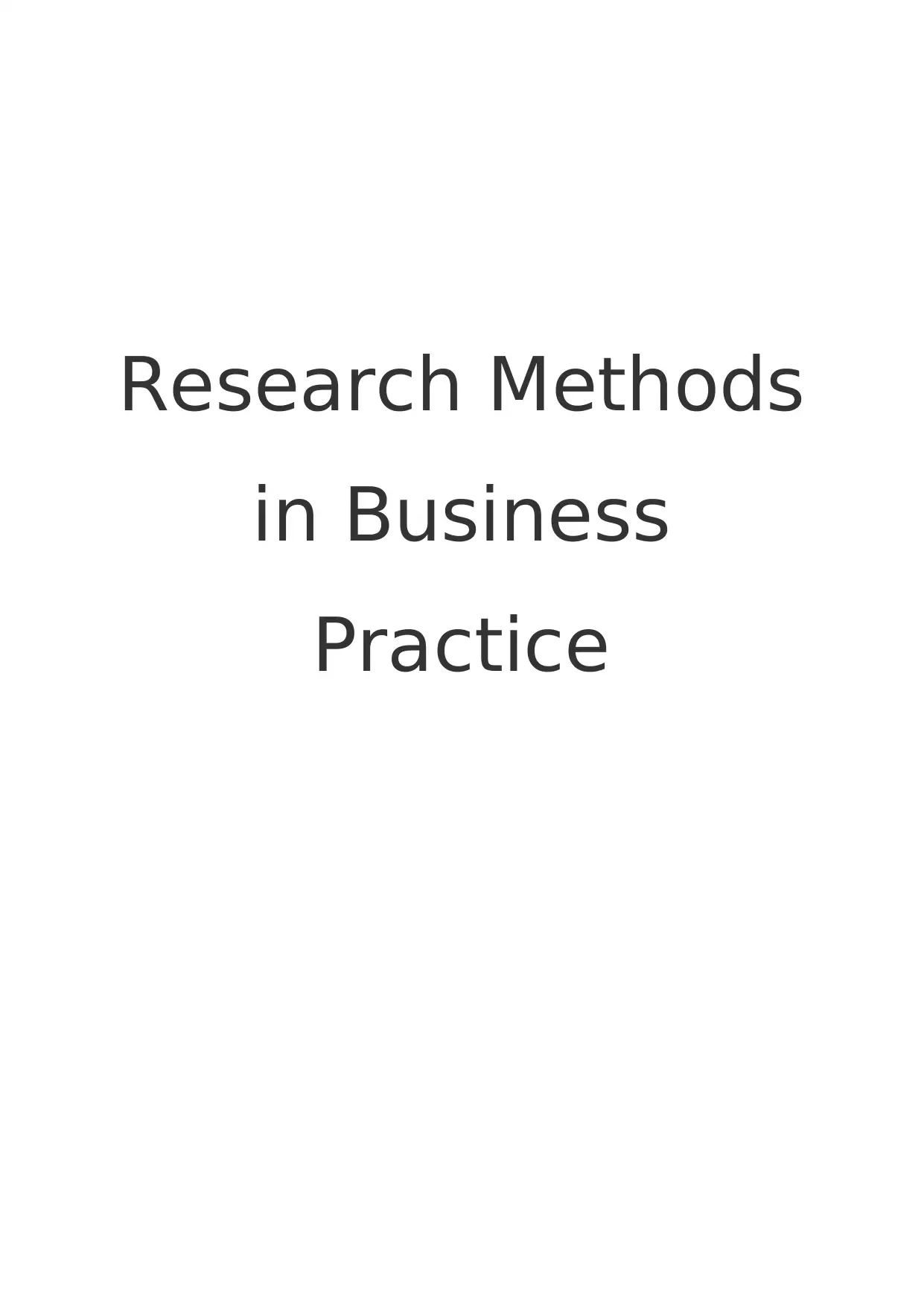
Research Methods
in Business
Practice
in Business
Practice
Paraphrase This Document
Need a fresh take? Get an instant paraphrase of this document with our AI Paraphraser
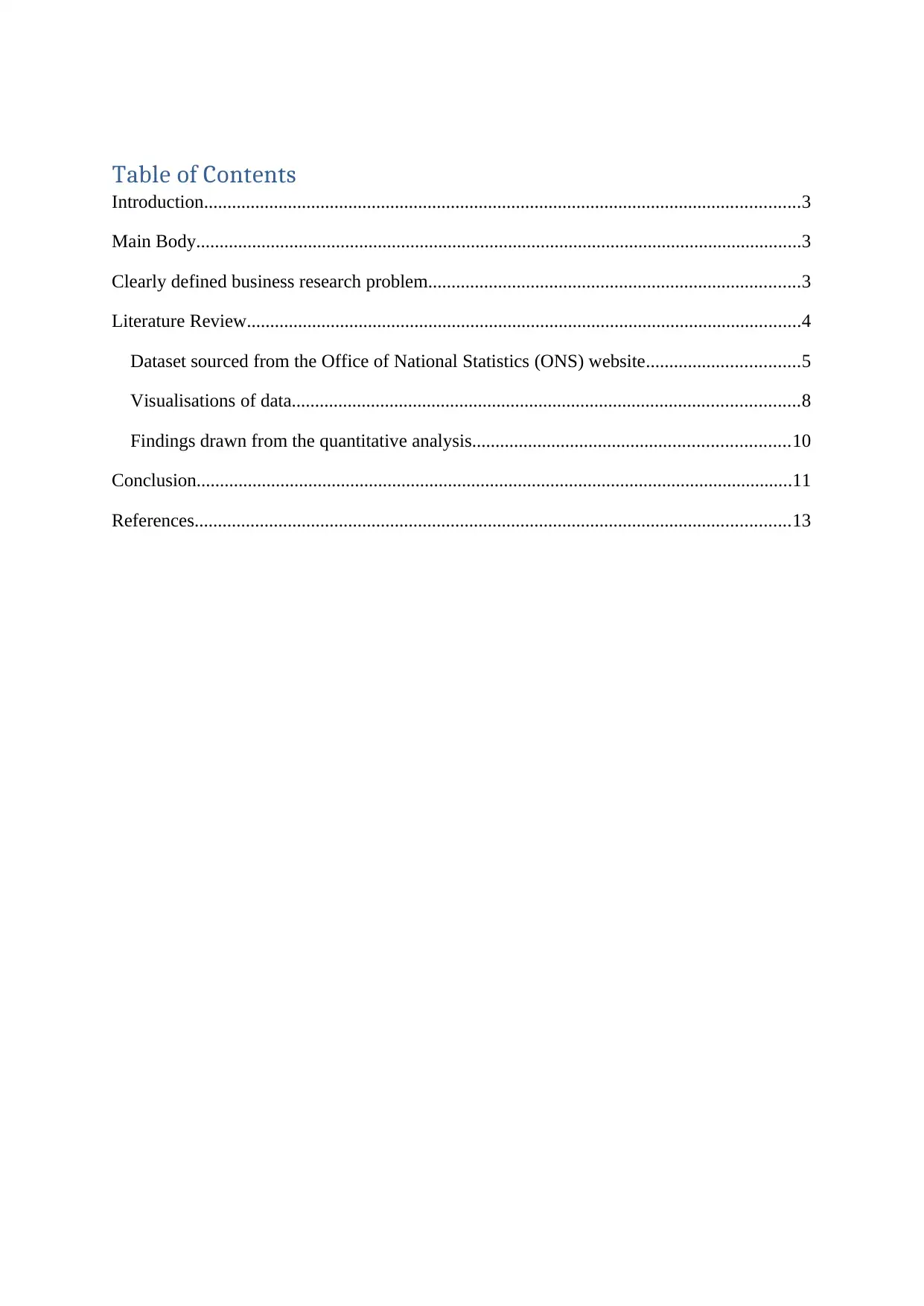
Table of Contents
Introduction................................................................................................................................3
Main Body..................................................................................................................................3
Clearly defined business research problem................................................................................3
Literature Review.......................................................................................................................4
Dataset sourced from the Office of National Statistics (ONS) website.................................5
Visualisations of data.............................................................................................................8
Findings drawn from the quantitative analysis....................................................................10
Conclusion................................................................................................................................11
References................................................................................................................................13
Introduction................................................................................................................................3
Main Body..................................................................................................................................3
Clearly defined business research problem................................................................................3
Literature Review.......................................................................................................................4
Dataset sourced from the Office of National Statistics (ONS) website.................................5
Visualisations of data.............................................................................................................8
Findings drawn from the quantitative analysis....................................................................10
Conclusion................................................................................................................................11
References................................................................................................................................13
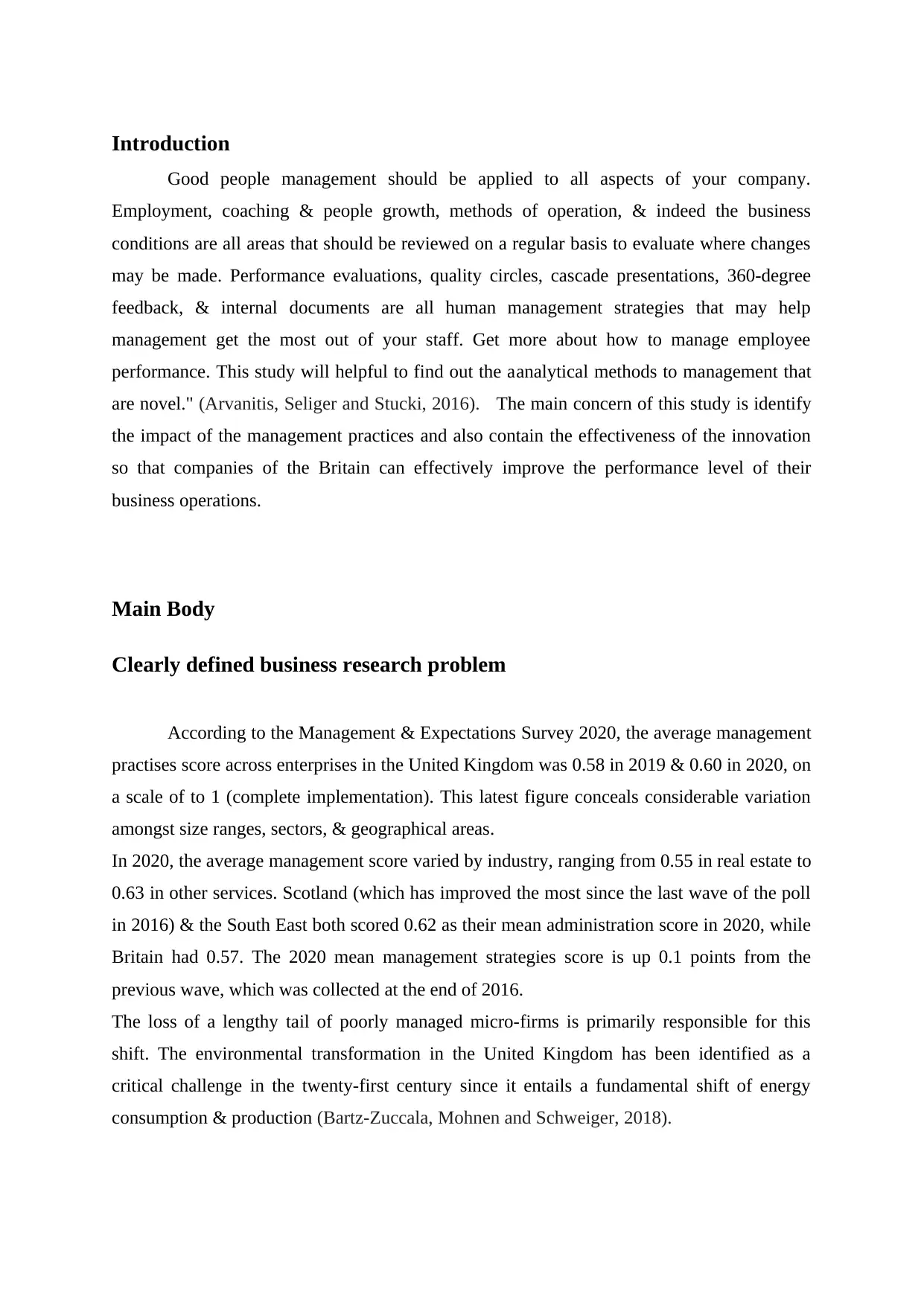
Introduction
Good people management should be applied to all aspects of your company.
Employment, coaching & people growth, methods of operation, & indeed the business
conditions are all areas that should be reviewed on a regular basis to evaluate where changes
may be made. Performance evaluations, quality circles, cascade presentations, 360-degree
feedback, & internal documents are all human management strategies that may help
management get the most out of your staff. Get more about how to manage employee
performance. This study will helpful to find out the aanalytical methods to management that
are novel." (Arvanitis, Seliger and Stucki, 2016). The main concern of this study is identify
the impact of the management practices and also contain the effectiveness of the innovation
so that companies of the Britain can effectively improve the performance level of their
business operations.
Main Body
Clearly defined business research problem
According to the Management & Expectations Survey 2020, the average management
practises score across enterprises in the United Kingdom was 0.58 in 2019 & 0.60 in 2020, on
a scale of to 1 (complete implementation). This latest figure conceals considerable variation
amongst size ranges, sectors, & geographical areas.
In 2020, the average management score varied by industry, ranging from 0.55 in real estate to
0.63 in other services. Scotland (which has improved the most since the last wave of the poll
in 2016) & the South East both scored 0.62 as their mean administration score in 2020, while
Britain had 0.57. The 2020 mean management strategies score is up 0.1 points from the
previous wave, which was collected at the end of 2016.
The loss of a lengthy tail of poorly managed micro-firms is primarily responsible for this
shift. The environmental transformation in the United Kingdom has been identified as a
critical challenge in the twenty-first century since it entails a fundamental shift of energy
consumption & production (Bartz-Zuccala, Mohnen and Schweiger, 2018).
Good people management should be applied to all aspects of your company.
Employment, coaching & people growth, methods of operation, & indeed the business
conditions are all areas that should be reviewed on a regular basis to evaluate where changes
may be made. Performance evaluations, quality circles, cascade presentations, 360-degree
feedback, & internal documents are all human management strategies that may help
management get the most out of your staff. Get more about how to manage employee
performance. This study will helpful to find out the aanalytical methods to management that
are novel." (Arvanitis, Seliger and Stucki, 2016). The main concern of this study is identify
the impact of the management practices and also contain the effectiveness of the innovation
so that companies of the Britain can effectively improve the performance level of their
business operations.
Main Body
Clearly defined business research problem
According to the Management & Expectations Survey 2020, the average management
practises score across enterprises in the United Kingdom was 0.58 in 2019 & 0.60 in 2020, on
a scale of to 1 (complete implementation). This latest figure conceals considerable variation
amongst size ranges, sectors, & geographical areas.
In 2020, the average management score varied by industry, ranging from 0.55 in real estate to
0.63 in other services. Scotland (which has improved the most since the last wave of the poll
in 2016) & the South East both scored 0.62 as their mean administration score in 2020, while
Britain had 0.57. The 2020 mean management strategies score is up 0.1 points from the
previous wave, which was collected at the end of 2016.
The loss of a lengthy tail of poorly managed micro-firms is primarily responsible for this
shift. The environmental transformation in the United Kingdom has been identified as a
critical challenge in the twenty-first century since it entails a fundamental shift of energy
consumption & production (Bartz-Zuccala, Mohnen and Schweiger, 2018).
⊘ This is a preview!⊘
Do you want full access?
Subscribe today to unlock all pages.

Trusted by 1+ million students worldwide
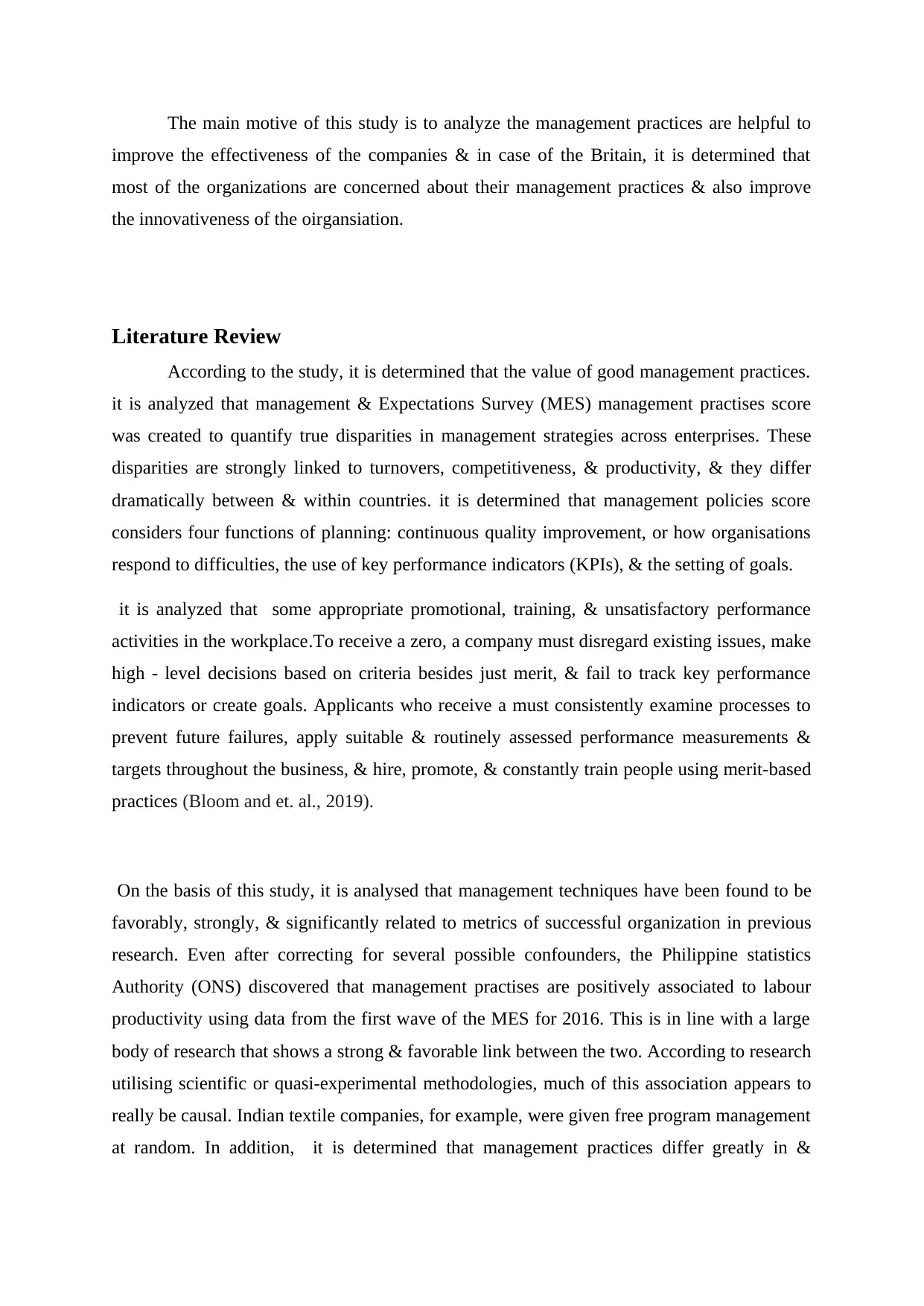
The main motive of this study is to analyze the management practices are helpful to
improve the effectiveness of the companies & in case of the Britain, it is determined that
most of the organizations are concerned about their management practices & also improve
the innovativeness of the oirgansiation.
Literature Review
According to the study, it is determined that the value of good management practices.
it is analyzed that management & Expectations Survey (MES) management practises score
was created to quantify true disparities in management strategies across enterprises. These
disparities are strongly linked to turnovers, competitiveness, & productivity, & they differ
dramatically between & within countries. it is determined that management policies score
considers four functions of planning: continuous quality improvement, or how organisations
respond to difficulties, the use of key performance indicators (KPIs), & the setting of goals.
it is analyzed that some appropriate promotional, training, & unsatisfactory performance
activities in the workplace.To receive a zero, a company must disregard existing issues, make
high - level decisions based on criteria besides just merit, & fail to track key performance
indicators or create goals. Applicants who receive a must consistently examine processes to
prevent future failures, apply suitable & routinely assessed performance measurements &
targets throughout the business, & hire, promote, & constantly train people using merit-based
practices (Bloom and et. al., 2019).
On the basis of this study, it is analysed that management techniques have been found to be
favorably, strongly, & significantly related to metrics of successful organization in previous
research. Even after correcting for several possible confounders, the Philippine statistics
Authority (ONS) discovered that management practises are positively associated to labour
productivity using data from the first wave of the MES for 2016. This is in line with a large
body of research that shows a strong & favorable link between the two. According to research
utilising scientific or quasi-experimental methodologies, much of this association appears to
really be causal. Indian textile companies, for example, were given free program management
at random. In addition, it is determined that management practices differ greatly in &
improve the effectiveness of the companies & in case of the Britain, it is determined that
most of the organizations are concerned about their management practices & also improve
the innovativeness of the oirgansiation.
Literature Review
According to the study, it is determined that the value of good management practices.
it is analyzed that management & Expectations Survey (MES) management practises score
was created to quantify true disparities in management strategies across enterprises. These
disparities are strongly linked to turnovers, competitiveness, & productivity, & they differ
dramatically between & within countries. it is determined that management policies score
considers four functions of planning: continuous quality improvement, or how organisations
respond to difficulties, the use of key performance indicators (KPIs), & the setting of goals.
it is analyzed that some appropriate promotional, training, & unsatisfactory performance
activities in the workplace.To receive a zero, a company must disregard existing issues, make
high - level decisions based on criteria besides just merit, & fail to track key performance
indicators or create goals. Applicants who receive a must consistently examine processes to
prevent future failures, apply suitable & routinely assessed performance measurements &
targets throughout the business, & hire, promote, & constantly train people using merit-based
practices (Bloom and et. al., 2019).
On the basis of this study, it is analysed that management techniques have been found to be
favorably, strongly, & significantly related to metrics of successful organization in previous
research. Even after correcting for several possible confounders, the Philippine statistics
Authority (ONS) discovered that management practises are positively associated to labour
productivity using data from the first wave of the MES for 2016. This is in line with a large
body of research that shows a strong & favorable link between the two. According to research
utilising scientific or quasi-experimental methodologies, much of this association appears to
really be causal. Indian textile companies, for example, were given free program management
at random. In addition, it is determined that management practices differ greatly in &
Paraphrase This Document
Need a fresh take? Get an instant paraphrase of this document with our AI Paraphraser
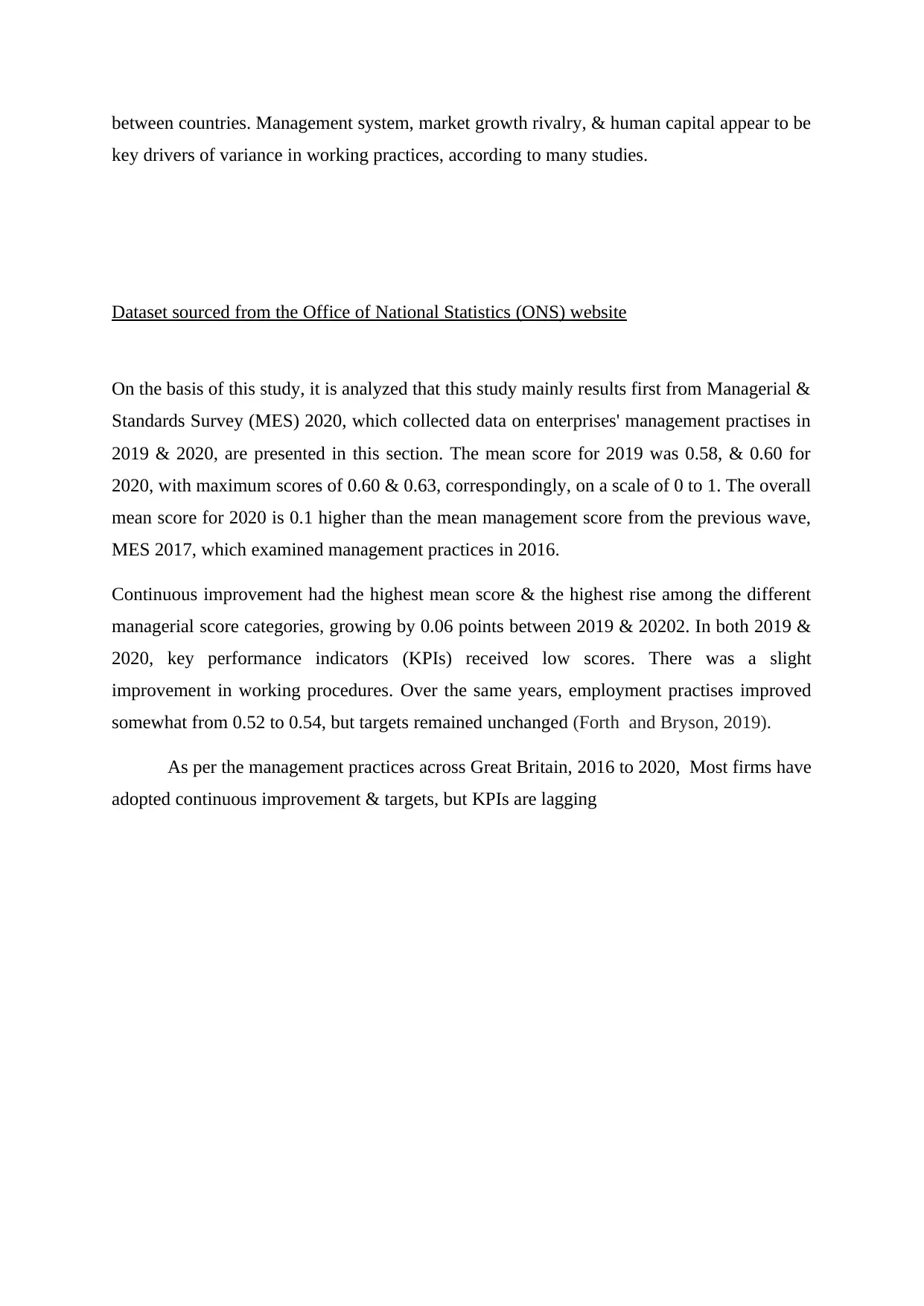
between countries. Management system, market growth rivalry, & human capital appear to be
key drivers of variance in working practices, according to many studies.
Dataset sourced from the Office of National Statistics (ONS) website
On the basis of this study, it is analyzed that this study mainly results first from Managerial &
Standards Survey (MES) 2020, which collected data on enterprises' management practises in
2019 & 2020, are presented in this section. The mean score for 2019 was 0.58, & 0.60 for
2020, with maximum scores of 0.60 & 0.63, correspondingly, on a scale of 0 to 1. The overall
mean score for 2020 is 0.1 higher than the mean management score from the previous wave,
MES 2017, which examined management practices in 2016.
Continuous improvement had the highest mean score & the highest rise among the different
managerial score categories, growing by 0.06 points between 2019 & 20202. In both 2019 &
2020, key performance indicators (KPIs) received low scores. There was a slight
improvement in working procedures. Over the same years, employment practises improved
somewhat from 0.52 to 0.54, but targets remained unchanged (Forth and Bryson, 2019).
As per the management practices across Great Britain, 2016 to 2020, Most firms have
adopted continuous improvement & targets, but KPIs are lagging
key drivers of variance in working practices, according to many studies.
Dataset sourced from the Office of National Statistics (ONS) website
On the basis of this study, it is analyzed that this study mainly results first from Managerial &
Standards Survey (MES) 2020, which collected data on enterprises' management practises in
2019 & 2020, are presented in this section. The mean score for 2019 was 0.58, & 0.60 for
2020, with maximum scores of 0.60 & 0.63, correspondingly, on a scale of 0 to 1. The overall
mean score for 2020 is 0.1 higher than the mean management score from the previous wave,
MES 2017, which examined management practices in 2016.
Continuous improvement had the highest mean score & the highest rise among the different
managerial score categories, growing by 0.06 points between 2019 & 20202. In both 2019 &
2020, key performance indicators (KPIs) received low scores. There was a slight
improvement in working procedures. Over the same years, employment practises improved
somewhat from 0.52 to 0.54, but targets remained unchanged (Forth and Bryson, 2019).
As per the management practices across Great Britain, 2016 to 2020, Most firms have
adopted continuous improvement & targets, but KPIs are lagging
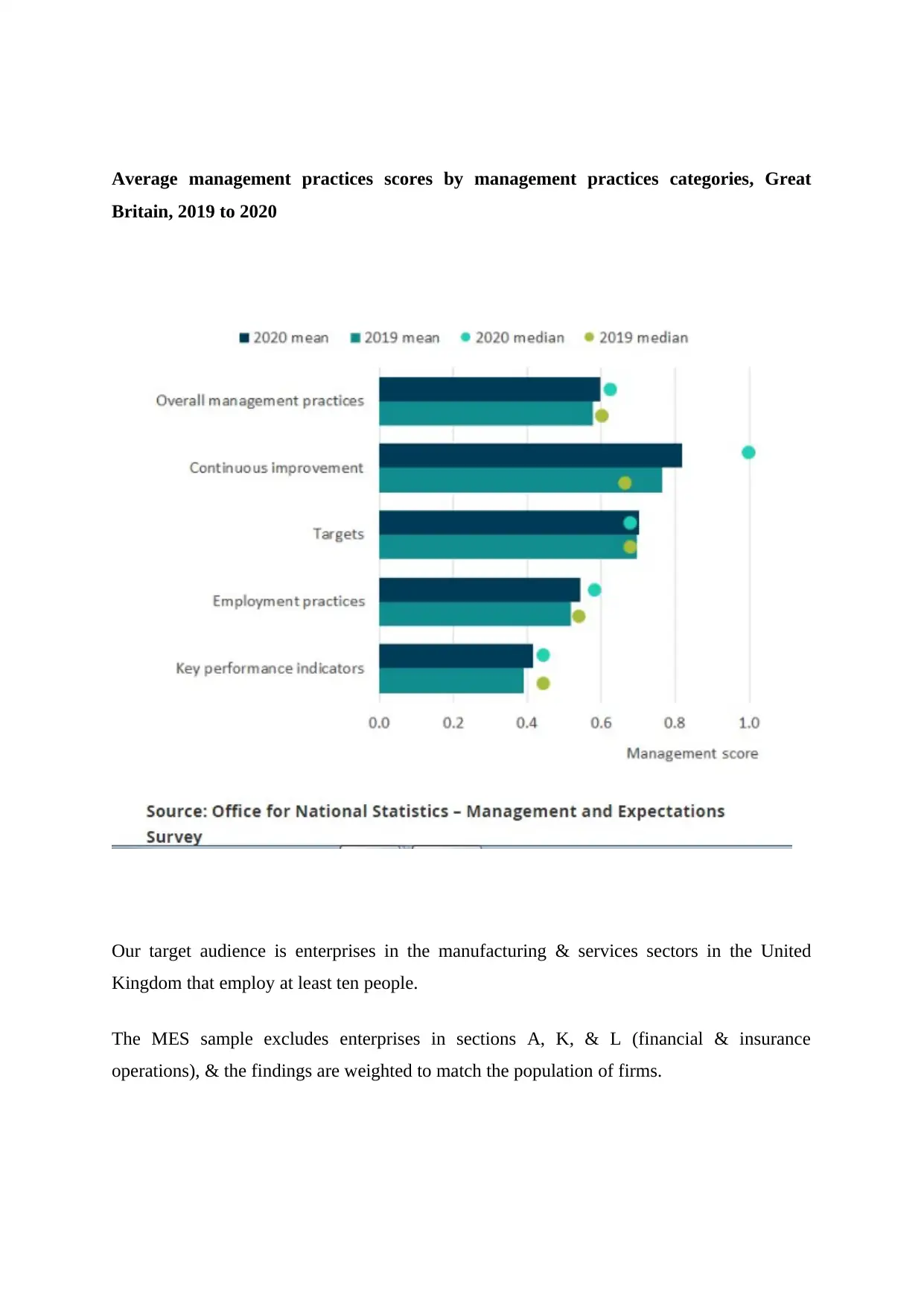
Average management practices scores by management practices categories, Great
Britain, 2019 to 2020
Our target audience is enterprises in the manufacturing & services sectors in the United
Kingdom that employ at least ten people.
The MES sample excludes enterprises in sections A, K, & L (financial & insurance
operations), & the findings are weighted to match the population of firms.
Britain, 2019 to 2020
Our target audience is enterprises in the manufacturing & services sectors in the United
Kingdom that employ at least ten people.
The MES sample excludes enterprises in sections A, K, & L (financial & insurance
operations), & the findings are weighted to match the population of firms.
⊘ This is a preview!⊘
Do you want full access?
Subscribe today to unlock all pages.

Trusted by 1+ million students worldwide
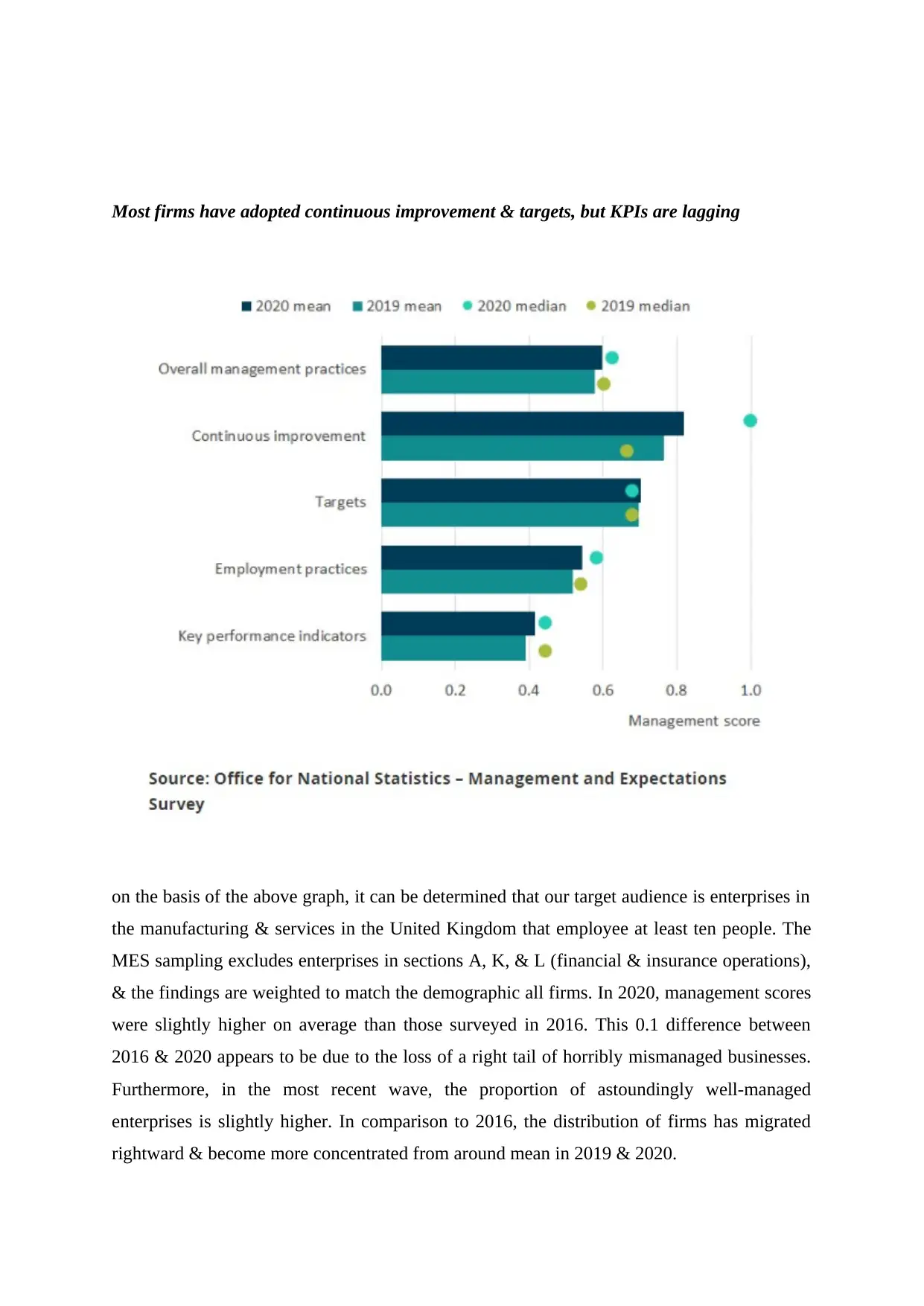
Most firms have adopted continuous improvement & targets, but KPIs are lagging
on the basis of the above graph, it can be determined that our target audience is enterprises in
the manufacturing & services in the United Kingdom that employee at least ten people. The
MES sampling excludes enterprises in sections A, K, & L (financial & insurance operations),
& the findings are weighted to match the demographic all firms. In 2020, management scores
were slightly higher on average than those surveyed in 2016. This 0.1 difference between
2016 & 2020 appears to be due to the loss of a right tail of horribly mismanaged businesses.
Furthermore, in the most recent wave, the proportion of astoundingly well-managed
enterprises is slightly higher. In comparison to 2016, the distribution of firms has migrated
rightward & become more concentrated from around mean in 2019 & 2020.
on the basis of the above graph, it can be determined that our target audience is enterprises in
the manufacturing & services in the United Kingdom that employee at least ten people. The
MES sampling excludes enterprises in sections A, K, & L (financial & insurance operations),
& the findings are weighted to match the demographic all firms. In 2020, management scores
were slightly higher on average than those surveyed in 2016. This 0.1 difference between
2016 & 2020 appears to be due to the loss of a right tail of horribly mismanaged businesses.
Furthermore, in the most recent wave, the proportion of astoundingly well-managed
enterprises is slightly higher. In comparison to 2016, the distribution of firms has migrated
rightward & become more concentrated from around mean in 2019 & 2020.
Paraphrase This Document
Need a fresh take? Get an instant paraphrase of this document with our AI Paraphraser
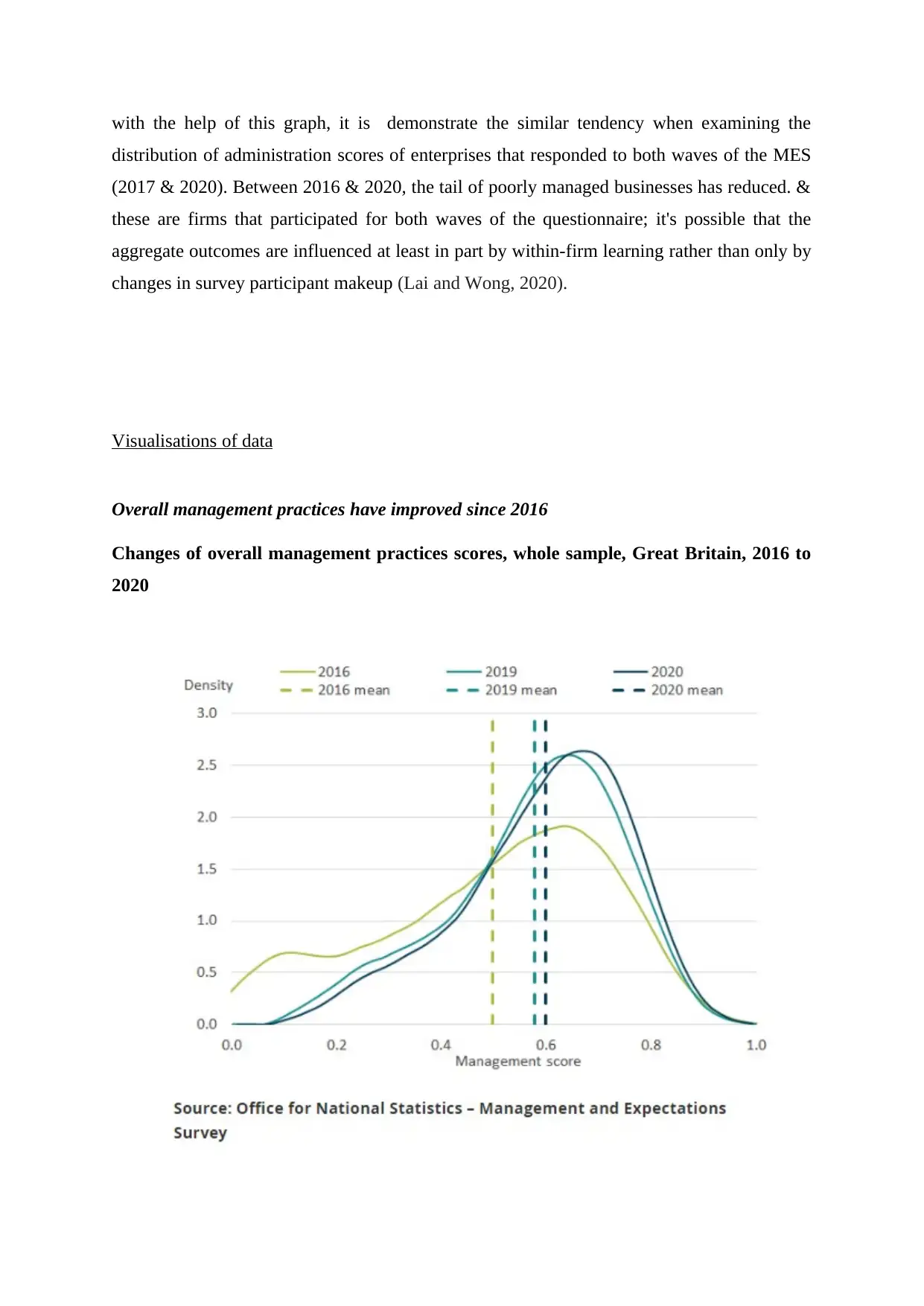
with the help of this graph, it is demonstrate the similar tendency when examining the
distribution of administration scores of enterprises that responded to both waves of the MES
(2017 & 2020). Between 2016 & 2020, the tail of poorly managed businesses has reduced. &
these are firms that participated for both waves of the questionnaire; it's possible that the
aggregate outcomes are influenced at least in part by within-firm learning rather than only by
changes in survey participant makeup (Lai and Wong, 2020).
Visualisations of data
Overall management practices have improved since 2016
Changes of overall management practices scores, whole sample, Great Britain, 2016 to
2020
distribution of administration scores of enterprises that responded to both waves of the MES
(2017 & 2020). Between 2016 & 2020, the tail of poorly managed businesses has reduced. &
these are firms that participated for both waves of the questionnaire; it's possible that the
aggregate outcomes are influenced at least in part by within-firm learning rather than only by
changes in survey participant makeup (Lai and Wong, 2020).
Visualisations of data
Overall management practices have improved since 2016
Changes of overall management practices scores, whole sample, Great Britain, 2016 to
2020
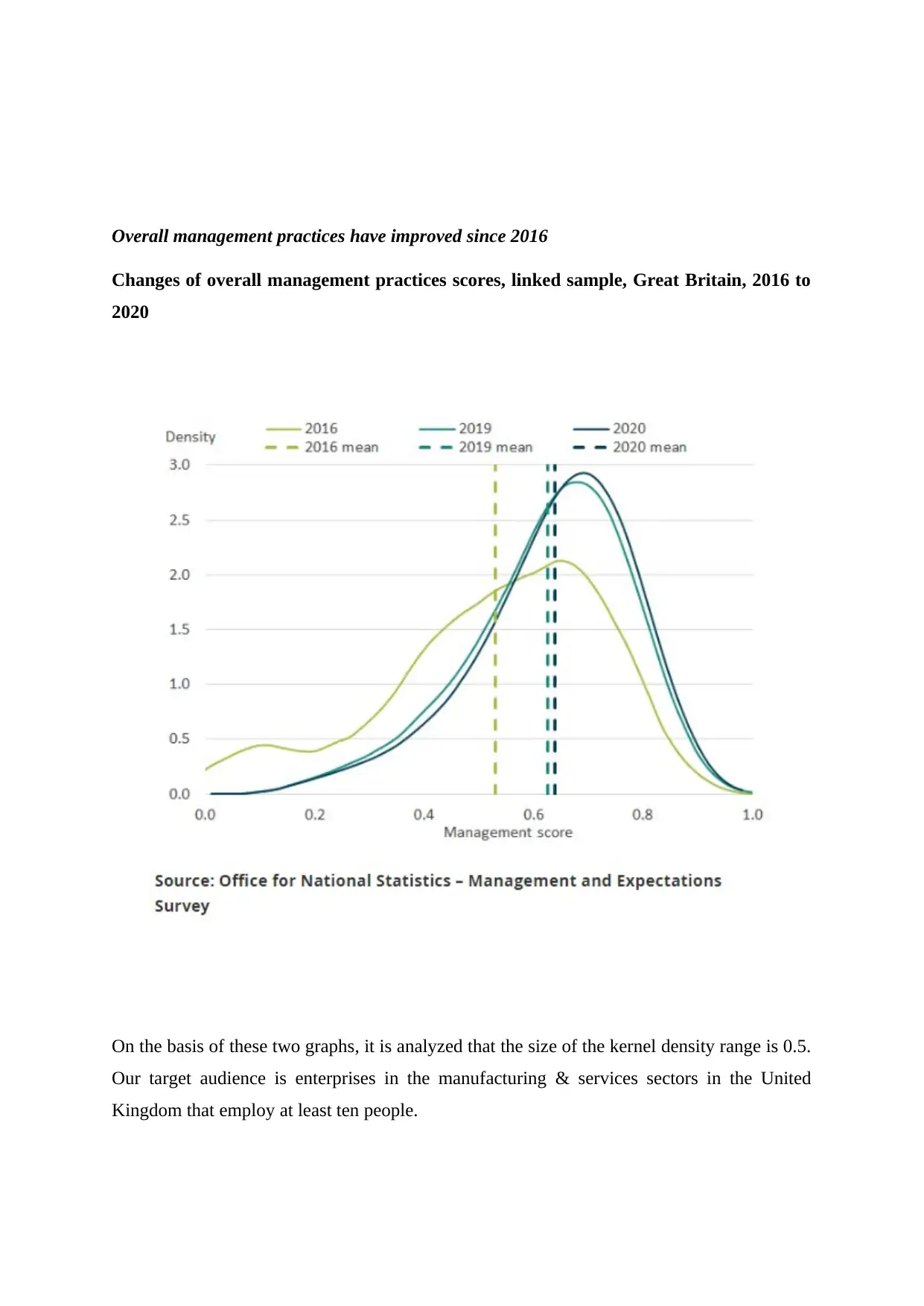
Overall management practices have improved since 2016
Changes of overall management practices scores, linked sample, Great Britain, 2016 to
2020
On the basis of these two graphs, it is analyzed that the size of the kernel density range is 0.5.
Our target audience is enterprises in the manufacturing & services sectors in the United
Kingdom that employ at least ten people.
Changes of overall management practices scores, linked sample, Great Britain, 2016 to
2020
On the basis of these two graphs, it is analyzed that the size of the kernel density range is 0.5.
Our target audience is enterprises in the manufacturing & services sectors in the United
Kingdom that employ at least ten people.
⊘ This is a preview!⊘
Do you want full access?
Subscribe today to unlock all pages.

Trusted by 1+ million students worldwide
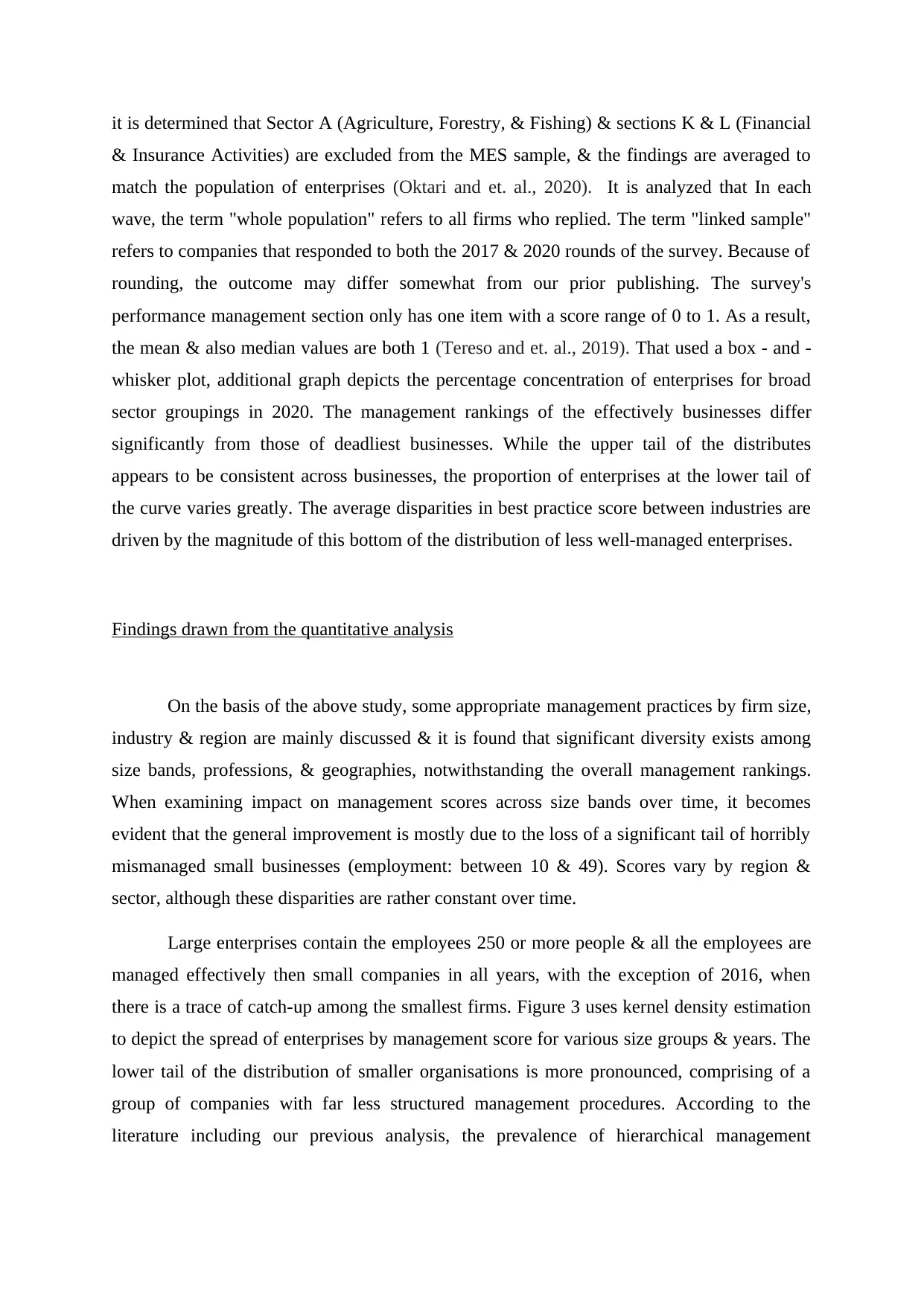
it is determined that Sector A (Agriculture, Forestry, & Fishing) & sections K & L (Financial
& Insurance Activities) are excluded from the MES sample, & the findings are averaged to
match the population of enterprises (Oktari and et. al., 2020). It is analyzed that In each
wave, the term "whole population" refers to all firms who replied. The term "linked sample"
refers to companies that responded to both the 2017 & 2020 rounds of the survey. Because of
rounding, the outcome may differ somewhat from our prior publishing. The survey's
performance management section only has one item with a score range of 0 to 1. As a result,
the mean & also median values are both 1 (Tereso and et. al., 2019). That used a box - and -
whisker plot, additional graph depicts the percentage concentration of enterprises for broad
sector groupings in 2020. The management rankings of the effectively businesses differ
significantly from those of deadliest businesses. While the upper tail of the distributes
appears to be consistent across businesses, the proportion of enterprises at the lower tail of
the curve varies greatly. The average disparities in best practice score between industries are
driven by the magnitude of this bottom of the distribution of less well-managed enterprises.
Findings drawn from the quantitative analysis
On the basis of the above study, some appropriate management practices by firm size,
industry & region are mainly discussed & it is found that significant diversity exists among
size bands, professions, & geographies, notwithstanding the overall management rankings.
When examining impact on management scores across size bands over time, it becomes
evident that the general improvement is mostly due to the loss of a significant tail of horribly
mismanaged small businesses (employment: between 10 & 49). Scores vary by region &
sector, although these disparities are rather constant over time.
Large enterprises contain the employees 250 or more people & all the employees are
managed effectively then small companies in all years, with the exception of 2016, when
there is a trace of catch-up among the smallest firms. Figure 3 uses kernel density estimation
to depict the spread of enterprises by management score for various size groups & years. The
lower tail of the distribution of smaller organisations is more pronounced, comprising of a
group of companies with far less structured management procedures. According to the
literature including our previous analysis, the prevalence of hierarchical management
& Insurance Activities) are excluded from the MES sample, & the findings are averaged to
match the population of enterprises (Oktari and et. al., 2020). It is analyzed that In each
wave, the term "whole population" refers to all firms who replied. The term "linked sample"
refers to companies that responded to both the 2017 & 2020 rounds of the survey. Because of
rounding, the outcome may differ somewhat from our prior publishing. The survey's
performance management section only has one item with a score range of 0 to 1. As a result,
the mean & also median values are both 1 (Tereso and et. al., 2019). That used a box - and -
whisker plot, additional graph depicts the percentage concentration of enterprises for broad
sector groupings in 2020. The management rankings of the effectively businesses differ
significantly from those of deadliest businesses. While the upper tail of the distributes
appears to be consistent across businesses, the proportion of enterprises at the lower tail of
the curve varies greatly. The average disparities in best practice score between industries are
driven by the magnitude of this bottom of the distribution of less well-managed enterprises.
Findings drawn from the quantitative analysis
On the basis of the above study, some appropriate management practices by firm size,
industry & region are mainly discussed & it is found that significant diversity exists among
size bands, professions, & geographies, notwithstanding the overall management rankings.
When examining impact on management scores across size bands over time, it becomes
evident that the general improvement is mostly due to the loss of a significant tail of horribly
mismanaged small businesses (employment: between 10 & 49). Scores vary by region &
sector, although these disparities are rather constant over time.
Large enterprises contain the employees 250 or more people & all the employees are
managed effectively then small companies in all years, with the exception of 2016, when
there is a trace of catch-up among the smallest firms. Figure 3 uses kernel density estimation
to depict the spread of enterprises by management score for various size groups & years. The
lower tail of the distribution of smaller organisations is more pronounced, comprising of a
group of companies with far less structured management procedures. According to the
literature including our previous analysis, the prevalence of hierarchical management
Paraphrase This Document
Need a fresh take? Get an instant paraphrase of this document with our AI Paraphraser
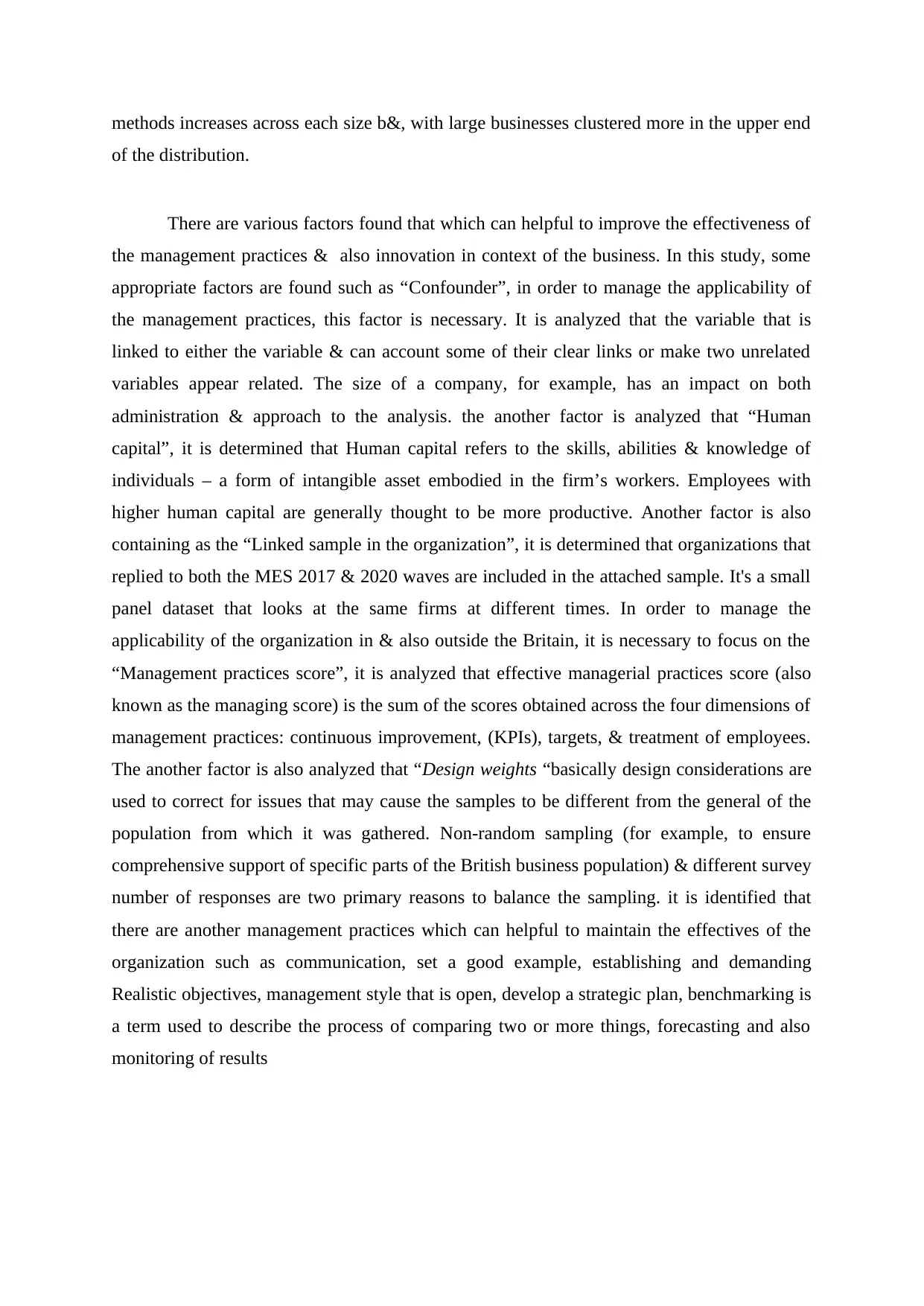
methods increases across each size b&, with large businesses clustered more in the upper end
of the distribution.
There are various factors found that which can helpful to improve the effectiveness of
the management practices & also innovation in context of the business. In this study, some
appropriate factors are found such as “Confounder”, in order to manage the applicability of
the management practices, this factor is necessary. It is analyzed that the variable that is
linked to either the variable & can account some of their clear links or make two unrelated
variables appear related. The size of a company, for example, has an impact on both
administration & approach to the analysis. the another factor is analyzed that “Human
capital”, it is determined that Human capital refers to the skills, abilities & knowledge of
individuals – a form of intangible asset embodied in the firm’s workers. Employees with
higher human capital are generally thought to be more productive. Another factor is also
containing as the “Linked sample in the organization”, it is determined that organizations that
replied to both the MES 2017 & 2020 waves are included in the attached sample. It's a small
panel dataset that looks at the same firms at different times. In order to manage the
applicability of the organization in & also outside the Britain, it is necessary to focus on the
“Management practices score”, it is analyzed that effective managerial practices score (also
known as the managing score) is the sum of the scores obtained across the four dimensions of
management practices: continuous improvement, (KPIs), targets, & treatment of employees.
The another factor is also analyzed that “Design weights “basically design considerations are
used to correct for issues that may cause the samples to be different from the general of the
population from which it was gathered. Non-random sampling (for example, to ensure
comprehensive support of specific parts of the British business population) & different survey
number of responses are two primary reasons to balance the sampling. it is identified that
there are another management practices which can helpful to maintain the effectives of the
organization such as communication, set a good example, establishing and demanding
Realistic objectives, management style that is open, develop a strategic plan, benchmarking is
a term used to describe the process of comparing two or more things, forecasting and also
monitoring of results
of the distribution.
There are various factors found that which can helpful to improve the effectiveness of
the management practices & also innovation in context of the business. In this study, some
appropriate factors are found such as “Confounder”, in order to manage the applicability of
the management practices, this factor is necessary. It is analyzed that the variable that is
linked to either the variable & can account some of their clear links or make two unrelated
variables appear related. The size of a company, for example, has an impact on both
administration & approach to the analysis. the another factor is analyzed that “Human
capital”, it is determined that Human capital refers to the skills, abilities & knowledge of
individuals – a form of intangible asset embodied in the firm’s workers. Employees with
higher human capital are generally thought to be more productive. Another factor is also
containing as the “Linked sample in the organization”, it is determined that organizations that
replied to both the MES 2017 & 2020 waves are included in the attached sample. It's a small
panel dataset that looks at the same firms at different times. In order to manage the
applicability of the organization in & also outside the Britain, it is necessary to focus on the
“Management practices score”, it is analyzed that effective managerial practices score (also
known as the managing score) is the sum of the scores obtained across the four dimensions of
management practices: continuous improvement, (KPIs), targets, & treatment of employees.
The another factor is also analyzed that “Design weights “basically design considerations are
used to correct for issues that may cause the samples to be different from the general of the
population from which it was gathered. Non-random sampling (for example, to ensure
comprehensive support of specific parts of the British business population) & different survey
number of responses are two primary reasons to balance the sampling. it is identified that
there are another management practices which can helpful to maintain the effectives of the
organization such as communication, set a good example, establishing and demanding
Realistic objectives, management style that is open, develop a strategic plan, benchmarking is
a term used to describe the process of comparing two or more things, forecasting and also
monitoring of results
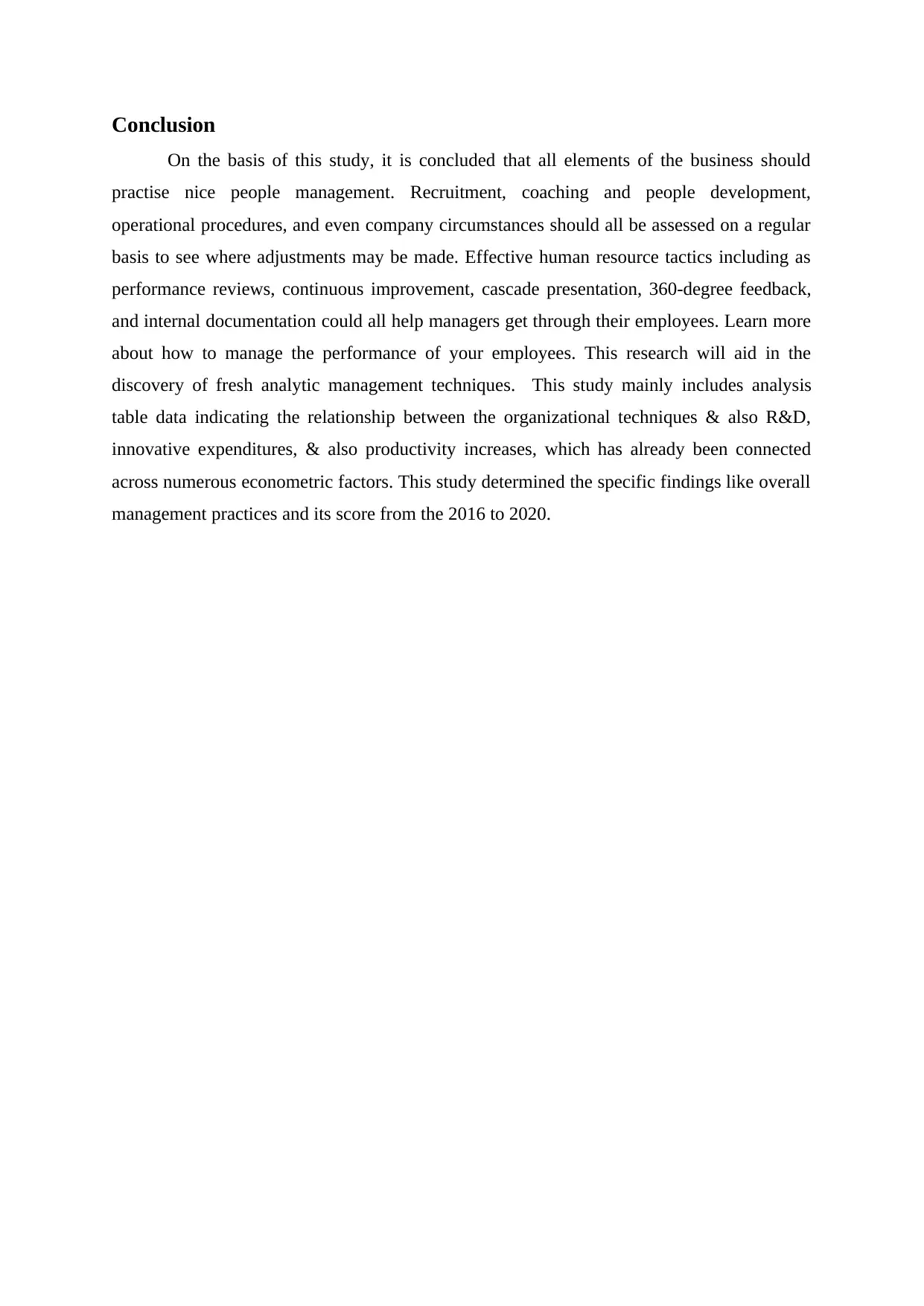
Conclusion
On the basis of this study, it is concluded that all elements of the business should
practise nice people management. Recruitment, coaching and people development,
operational procedures, and even company circumstances should all be assessed on a regular
basis to see where adjustments may be made. Effective human resource tactics including as
performance reviews, continuous improvement, cascade presentation, 360-degree feedback,
and internal documentation could all help managers get through their employees. Learn more
about how to manage the performance of your employees. This research will aid in the
discovery of fresh analytic management techniques. This study mainly includes analysis
table data indicating the relationship between the organizational techniques & also R&D,
innovative expenditures, & also productivity increases, which has already been connected
across numerous econometric factors. This study determined the specific findings like overall
management practices and its score from the 2016 to 2020.
On the basis of this study, it is concluded that all elements of the business should
practise nice people management. Recruitment, coaching and people development,
operational procedures, and even company circumstances should all be assessed on a regular
basis to see where adjustments may be made. Effective human resource tactics including as
performance reviews, continuous improvement, cascade presentation, 360-degree feedback,
and internal documentation could all help managers get through their employees. Learn more
about how to manage the performance of your employees. This research will aid in the
discovery of fresh analytic management techniques. This study mainly includes analysis
table data indicating the relationship between the organizational techniques & also R&D,
innovative expenditures, & also productivity increases, which has already been connected
across numerous econometric factors. This study determined the specific findings like overall
management practices and its score from the 2016 to 2020.
⊘ This is a preview!⊘
Do you want full access?
Subscribe today to unlock all pages.

Trusted by 1+ million students worldwide
1 out of 14
Related Documents
Your All-in-One AI-Powered Toolkit for Academic Success.
+13062052269
info@desklib.com
Available 24*7 on WhatsApp / Email
![[object Object]](/_next/static/media/star-bottom.7253800d.svg)
Unlock your academic potential
Copyright © 2020–2025 A2Z Services. All Rights Reserved. Developed and managed by ZUCOL.





